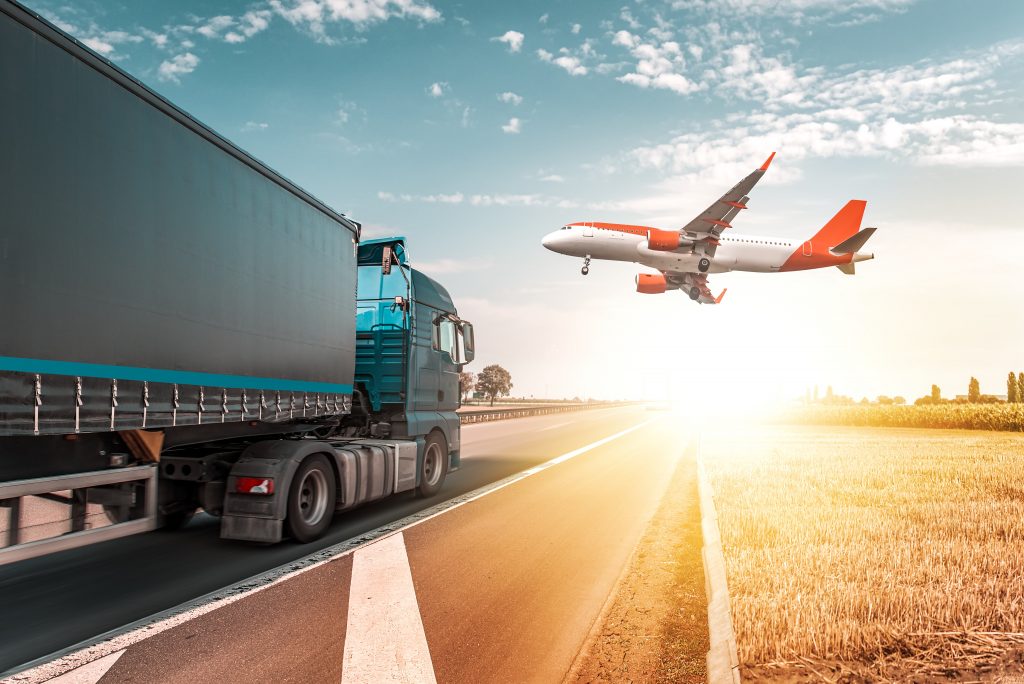Air freight service connections with the road transport sector
The modern logistics industry is like a circulatory system. We don’t regard an optimization process as separate from a business, rather as a combination of the different streams of money, people, goods and services. Today, we live in a world that has adopted the notion of delivering goods when and where a client wishes.
The air cargo sector is an integral part of the logistics industry. From pick-up to delivery, the air shipping process is quite straightforward. It can begin with a private individual or a major manufacturer with any product they wish to ship. Shippers (person or company supplying the goods that are shipped) have the option of taking an item directly to a carrier or of using third-party logistics providers (usually a freight forwarder) to find the best shipping possibilities and to ensure that all the arrangements are made.
Air transportation is a critical part of operating an efficient supply chain, both domestically and internationally. When a company prioritizes speed without delay (compared with shipping by sea), the primary transport option is air shipping. For example, medical and agricultural cargo must be shipped rapidly and efficiently.
Airfreight transportation is a complex process that can involve much paperwork. There is no room for mistakes that could cause long delays, as well as huge financial costs. A pertinent example can be seen from the past year of COVID-19 during which air freight transport was essential for the pharmaceutical companies. They had to ensure temperature-sensitive immunizations could be delivered worldwide in a safe and swift manner.
There are several ways in which goods can be shipped. Air cargo carriers provide various services according to customer demand. Integrated express carriers such as FedEx, UPS and DHL operate a large fleet of scheduled aircraft, trucks and couriers for door-to-door service. However, it should be noted that their system caters to only a minor part of the air freight market.
Most international shipping is consolidated, a method that combines several different LTL (less than load) shipments from various shippers into a single full container. A freight forwarder also may choose to ship products individually and immediately whenever an order comes through, though consolidated shipping is the most cost-efficient. Domestic shipments are typically unloaded at the destination airport and are then picked up and delivered to the consignee by truck.
In one of our previous blogs, Optimization of transportation in ports, we discussed the amount of time trucks spend in the terminal area from the moment cargo arrives until it is shipped out. We outlined the main problems that are connected to security measures and how to make the process more efficient.
Regarding international shipments, we need to add a few players (as opposed to domestic):
*CUSTOMS OFFICIALS (inspect shipments in the destination country);
*CUSTOMS BROKER (or IMPORTER, work with government agencies to clear cargo for entry into a country);
*CONSIGNEE (a buyer who receives the shipment after it is cleared to enter a country, before shipments are separated for individual customers/consignees and delivered by truck).

How does air freight work today?
- Identify the location of the cargo (factory, warehouse);
- Contact a forwarder/supplier – a trucking company to deliver shipment to the airport warehouse;
- Learn the transport approach inside the airport area, in accordance with local security requirements (may be carried out by airport vehicles);
- Complete customs clearance process for international delivery;
- Load onto aircraft;
- Prepare for transport of goods to airport warehouse;
- Pick-up by forwarder and deliver in trucks to the final destination.
Sounds easy? Maybe, however, this process has many pitfalls. A typical route is divided into 4 main parts:
- Transfer cargo by truck from a warehouse to the airport terminal warehouse
- Airport vehicles take the goods from the warehouse to the airplane
- After landing, goods are transferred from the airport to the terminal warehouse at the new location
- The goods are transported by truck to the final destination.
In each component there is a human factor and many vehicles that take care of cargo. Even in the beginning stages, when a cargo owner passes the goods to a forwarder, the commodities must be packed precisely according to the type of delivery; in addition, appropriate documentation must be provided.
Security restrictions exist in all airports to prevent dangerous goods from entering aircraft. Every shipping company should be aware of the regulations that apply for x-ray machine security screenings in an airport. “Known cargo” refers to a consignment for which the appropriate security controls have been applied; Known Consignors are those people who must maintain a high level of security to ensure cargo is safe to load on to an aircraft. After a shipment has cleared customs, the cargo is then further transported to the aircraft.
A significant effect of the COVID-19 pandemic was that many companies were forced to think about and adapt new ways to transfer goods across the world. The crisis highlighted the air cargo sector and the urgent need for sustainable digital adaptation, in order to establish collaborative business models.
How can we connect the airport system to road transport in a digitalized manner?
One platform! We believe the logistics solution lies in transitioning from individual software development to complex platform solutions; a single application that connects customers, shippers and carriers in one central place. Integration into one system will increase visibility of the entire process, resulting in more reliable and efficient cargo delivery. Applying a single platform would increase optimization of fleets involved in airport delivery (on route during rush hour and internal airport traffic). Such a model encourages sustainable behavior and also can reduce security concerns due to real-time visibility (a truck’s location can be viewed at all times). Efficient routing will result in fewer trucks on the way to the airport that will require security checks.

“When you need to innovate, you need collaboration.”
– Marissa Mayer, American businesswoman and investor, creator of Sunshine, platform based on artificial intelligence



